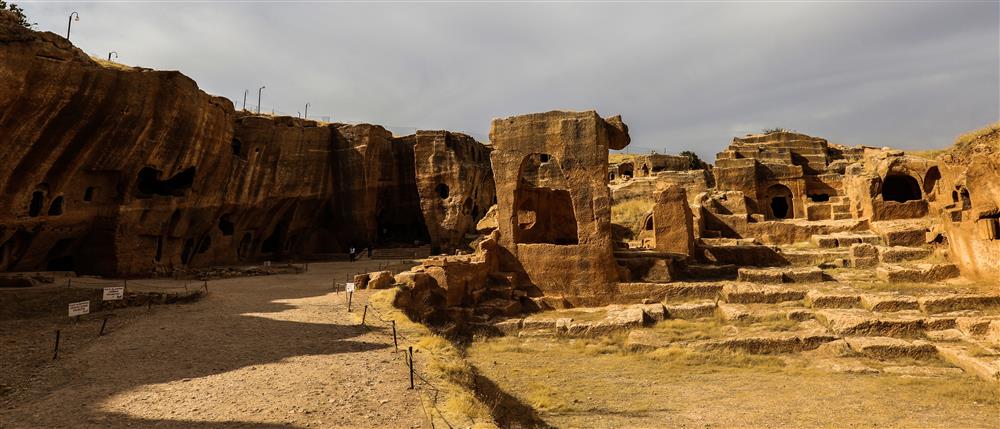YOLBUL(NAVIGATION)
Dara Antik Kenti Mardin’in 30 kilometre güneydoğusunda bulunan Oğuz Köyü'nde yer almaktadır. Tarihte Yukarı Mezopotamya'nın en önemli yerleşim yerlerinden birisi olan Dara, İmparator Anastasius'un (491-518) girişimleriyle 505 yılında, Doğu Roma İmparatorluğu’nun doğu sınırını Sasanilere karşı korumak için askeri amaçlı bir garnizon kenti olarak kurulmuştur. Roma İmparatorluğu'nun çöküşüyle şehir zaman içinde önemini yitirmiş ve harabeye dönmüştür.
Kaya içine oyulan yapılardan oluşan ve geniş bir alana yayılan Dara Antik Kenti’nin çevresi 4 kilometrelik bir surla korunmuştur. İç kale, kentin kuzeyinde ve 50 metre yüksekliğindeki tepenin üst düzlüğüne kurulmuştur. Kent içinde kilise, saray, çarşı, zindan, tophane ve su bendi kalıntıları halen görülebilmektedir. Ayrıca köyün etrafında tarihleri Geç Roma Dönemi’ne kadar giden mağara evlere rastlanmaktadır. Şehrin altında bulunan dev sarnıçlar ve kentin içinde yer alan koruma altına alınmış mezarlık görülmeye değer bir çok eserden bazılarıdır.
Dara'yla ilgili antik kaynaklara bakıldığında şehrin önemi daha iyi anlaşılacaktır. Örneğin Evagrius Scholasticus Dara için; Roma'nın en önemli sınır kalesi demiştir.
Yine başka bir Romalı tarihçi Marcus Junianus Justinus ise Dara'yı şöyle tasvir etmektedir; Seleucus Zapaortenon Dağı'nda, Dara adında bir şehir kurdu, öyle ki, hiçbir yer bundan daha güvenli veya daha hoş olamaz;çünkü o kadar sarp kayalarla çevrilidir ki, konumu nedeniyle gardiyana ihtiyacı yoktur.Dibindeki toprağın verimliliği o kadar fazladır ki, kendi ürünüyle birlikte depolanır.Bol su ırmaklarıyla beslenen bir çok pınar ve ağaç ve avın tüm zevkleriyle dolu bir yerdir burası.
Bazı tarihçilere göre Dünya tarihini değiştiren ve Büyük İskender'le III. Darius arasında gerçekleşen Gaugamela Muharebesi'de bu bölgede gerçekleşmiş ve bölgenin adı Darius'tan ilham alınarak Dara konulmuştur. Bu bilginin arkeolojik verilerle teyit edilmemesine ve Dara'nın bilinen tarihinin M.Ö 331 yılında gerçekleşen bu savaşla örtüşmemesine rağmen bölgenin savaşın gerçekleştiği sayılan Musul'daki bölgeyle olan benzerliği ve tarihi ipek yolu üzerinde konuşlanmış olması Dara'yı bu anlamda da değerli kılmaktadır.
Pazartesi günleri kapalıdır. Antik şehre girişler ücretsizdir.
Dara Ören Yeri mesai saatleri: 08:00 17:00
ENGLISH- DARA THE ANTIQUE CITY-
Dara Ancient City is located in Oğuz Village, 30 kilometers southeast of Mardin. Dara, one of the most important settlements of Upper Mesopotamia in history, was established as a military garrison city in 505 with the initiatives of Emperor Anastasius (491-518) to protect the eastern border of the Eastern Roman Empire against the Sassanids. Upon the collapse of Roman Empire, the ancient city of Dara lost its importance and turned into ruins over the course of time.
The ancient city of Dara, which consists of structures carved into the rock and spread over a wide area, was protected by a 4-kilometer wall. The inner castle was built on the north of the city and on the upper plain of a 50-meter-high hill. The ruins of churches, palaces, bazaars, dungeons, armory and water dam can still be seen in the city. In addition, cave houses dating back to the Late Roman Period are found around the village. The giant cisterns and the common graves under protection are some of the must see places in the ancient town.
Dara's importance can be better understood by tracing the ancient courses. For example Evagrius Scholasticus described Dara as; The most important frontier fortress of Rome.
Yet another Roman historian, Marcus Junianus Justinus, describes Dara as follows;Seleucus founded a city also, called Dara, in Mount Zapaortenon, of which the situation is such, that no place can be more secure or more pleasant; for it is so encircled with steep rocks, that the strength of its position needs no defenders; and such is the fertility of the adjacent soil, that it is stored with its own produce. Such too is the plenty of springs and wood, that it is amply supplied with streams of water, and abounds with all the pleasures of the chace.
Further some historians claim that the battle of Gaugamela between Alexander the Great and Darius III took place at Dara. Hence the name of the region derived from the King Darius. This claim can't be verified with archeological evidences or even the known history of Dara does not dates to back to 331 BC -the date when battle made-. Yet Dara has similarities with the region in Mosul where the battle venue is believed to be located. Moreover, archeological excavations are still going on in Dara region and each day scientists are finding new evidences.
There is no public transport to the area. The city is closed to visits on mondays. Entrance is free of charge.
